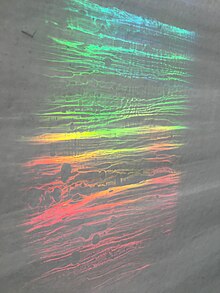
Back Lig Afrikaans Licht ALS ብርሃን Amharic Luz AN ضوء Arabic ܢܘܗܪܐ (ܚܙܝܬܐ) ARC شعا ARY النور ARZ পোহৰ Assamese Lluz AST

Light is a form of electromagnetic radiation. It is the natural agent that stimulates sight and makes things easy to see. Light is the opposite of darkness.
Light has a wavelength. Some wavelengths can be seen by the human eye. Others cannot.[1] Many animals can see light. They need it to find food, water, and other things.
Light makes up a part of both the electromagnetic spectrum and radiation given off by stars, like the sun. The light that comes from the sun reaches the Earth and makes it bright. This is called daytime.
The study of light is known as optics. When light hits an opaque object, it makes a shadow. When light hits a transparent object, it passes through it almost completely without making a significant shadow.
Light is a form of electromagnetic radiation that shows properties of both waves and particles. It is a form of energy. Light also keeps the Earth warm. Light exists in tiny energy packets called photons. Each wave has a wavelength or frequency. The human eye sees each wavelength as a different color. Rainbows show the entire spectrum of visible light. The separate colors, moving in from the outer edges, are red, orange, yellow, green, blue, indigo and violet. Other colors can be seen only with special cameras or instruments: Wavelengths up the frequency of red are called infrared, and higher than of violet are called ultraviolet.
The main properties of light are intensity, polarization, phase and orbital angular momentum.
In physics, the term light sometimes means electromagnetic radiation of any wavelength, whether it can be seen or not.[2][3]
- ↑ International Commission on Illumination 1987. International Lighting Vocabulary Archived 2010-02-27 at the Wayback Machine. Number 17.4. CIE, 4th edition. ISBN 978-3-900734-07-7.
By the International Lighting Vocabulary, the definition of light is: “Any radiation capable of causing a visual sensation directly.” - ↑ Gregory Hallock Smith (2006), Camera lenses: from box camera to digital, SPIE Press, p. 4, ISBN 9780819460936
- ↑ Narinder Kumar (2008), Comprehensive Physics XII, Laxmi Publications, p. 1416, ISBN 9788170085928